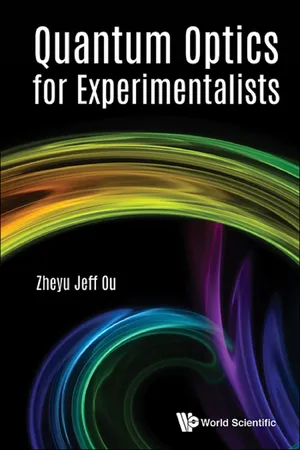
- 432 pages
- English
- ePUB (mobile friendly)
- Available on iOS & Android
Quantum Optics for Experimentalists
About this book
-->
This book on quantum optics is from the point of view of an experimentalist. It approaches the theory of quantum optics with the language of optical modes of classical wave theory, with which experimentalists are most familiar. This approach makes the transition easy from classical optics to quantum optics. The emphasis on the multimode description of an optical system is more realistic than in most quantum optics textbooks. After the theoretical part, the book goes directly to the two most basic experimental techniques in quantum optics and establishes the connection between the experiments and the theory. The applications include some key quantum optics experiments, and a few more current interests that deal with quantum correlation and entanglement, quantum noise in phase measurement and amplification, and quantum state measurement.
-->
Request Inspection Copy
--> Contents:
- Theoretical Foundations of Quantum Optics:
- Historical Development of Quantum Optics and A Brief Introduction
- Mode Theory of Optical Fields and Their Quantization
- Quantum States of Single-Mode Fields
- Quantum States of Multi-Mode Fields
- Theory of Photo-detection and Quantum Theory of Coherence
- Generation and Transformation of Quantum States
- Experimental Techniques in Quantum Optics and Their Applications:
- Experimental Techniques of Quantum Optics I: Photon Counting Technique
- Applications of Photon Counting Techniques: Multi-Photon Interference and Entanglement
- Experimental Techniques of Quantum Optics II: Detection of Continuous Photo-Currents
- Applications of Homodyne Detection Technique: Quantum Measurement of Continuous Variables
- Quantum Noise in Phase Measurement
- Appendices:
- Derivation of an Explicit Expression for Û of a Lossless Beam Splitter
- Evaluation of the Two Sums in Eq. (8.100)
-->
--> Readership: Advanced undergraduates, graduate students and researchers in quantum optics. -->
Quantum Optics;Optical Fields;Quantum States;Photo-Currents;Quantum Theory of Coherence;Entangled States;Phase Measurement0
Frequently asked questions
- Essential is ideal for learners and professionals who enjoy exploring a wide range of subjects. Access the Essential Library with 800,000+ trusted titles and best-sellers across business, personal growth, and the humanities. Includes unlimited reading time and Standard Read Aloud voice.
- Complete: Perfect for advanced learners and researchers needing full, unrestricted access. Unlock 1.4M+ books across hundreds of subjects, including academic and specialized titles. The Complete Plan also includes advanced features like Premium Read Aloud and Research Assistant.
Please note we cannot support devices running on iOS 13 and Android 7 or earlier. Learn more about using the app.
Information
PART 1
Theoretical Foundations of Quantum Optics
Chapter 1
Historical Development of Quantum Optics and A Brief Introduction
1.1Historical Background






Table of contents
- Cover
- Halftitle
- Title
- Copyright
- Dedication
- Preface
- Theoretical Foundations of Quantum Optics
- Experimental Techniques in Quantum Optics and Their Applications
- Appendix A Derivation of the Explicit Expression for Û of a Lossless Beam Splitter
- Appendix B Evaluation of the Two Sums in Eq. (8.100)
- Bibliography
- Index